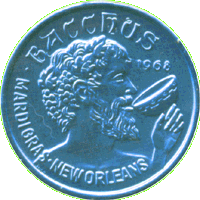![[ICC Carnival New Orleans]](g/mgtitle.gif)
![[Trinkets]](g/throw.gif)
Trinkets
Trinkets
Have you ever thought much about Mardi Gras throws? Obviously the prospect of getting something for free will entice one to grab for anything that flies by. But what items are the most sought-after? Everyone probably has a different opinion..
In the days leading to the Carnival season, the skillful artesians in Taiwan and China tend to work overtime producing the abundant trinkets parade goers will leap, lurch and stomp to acquire.
Doubloons
 These are brightly colored aluminum coins
about the size of a U.S. Silver Dollar. Doubloons are usually embossed
with the symbol of the krewe on one side, and the
year and theme of the parade on the other. A single Krewe may
have several different doubloons being thrown. Different colors
and styles of sometimes have significance: thrown by kings;
rarity; or popularity. Some krewes also mint bronze, silver and even
gold doubloons - these obviously aren't thrown in parades - but are instead
collected and generally made available only to Krewe members.
These are brightly colored aluminum coins
about the size of a U.S. Silver Dollar. Doubloons are usually embossed
with the symbol of the krewe on one side, and the
year and theme of the parade on the other. A single Krewe may
have several different doubloons being thrown. Different colors
and styles of sometimes have significance: thrown by kings;
rarity; or popularity. Some krewes also mint bronze, silver and even
gold doubloons - these obviously aren't thrown in parades - but are instead
collected and generally made available only to Krewe members.
![[COINS.GIF]](g/rexcoin.gif) Throwing doubloons was introduced in 1960 by Rex. Since then, collecting them has
become a major hobby. One of the most famous and rare aluminum doubloons is the
1960 Rex coin shown here.
Throwing doubloons was introduced in 1960 by Rex. Since then, collecting them has
become a major hobby. One of the most famous and rare aluminum doubloons is the
1960 Rex coin shown here.
There's no mistaking the distinctive sound of a doubloon hitting the pavement. It's guaranteed to get people hustling. Some locals can even identify the color or type of doubloon by its resonation as it rolls along.
Pop Quiz:
What's the difference between a veteran parade goer and a novice?
Answer: The novice has footprints on the back of his hand!



Copyright © 1996-2014, InterCommerce
Corporation,
All Rights Reserved Worldwide
Comments & Feedback
appreciated!
(http://www.icorp.net/icorp/feedback.htm)


Copyright © 1996-2014, InterCommerce Corporation, All Rights Reserved Worldwide
Comments & Feedback appreciated! (http://www.icorp.net/icorp/feedback.htm)